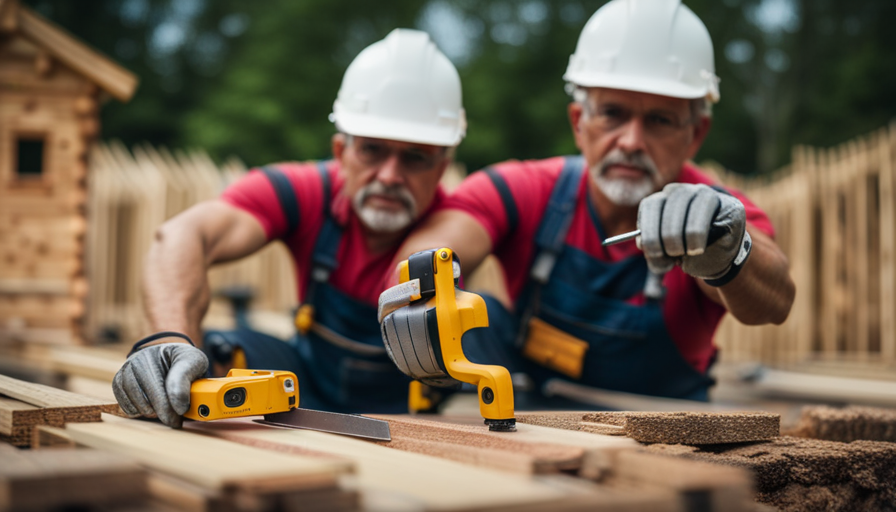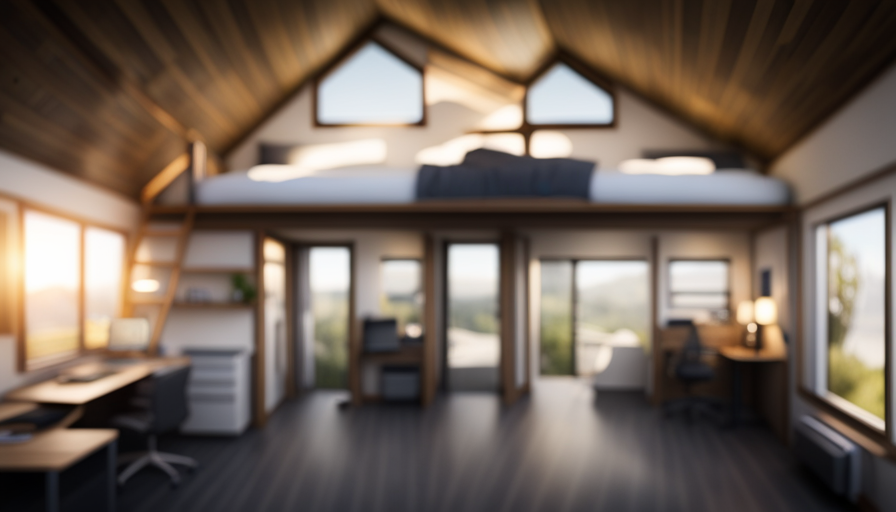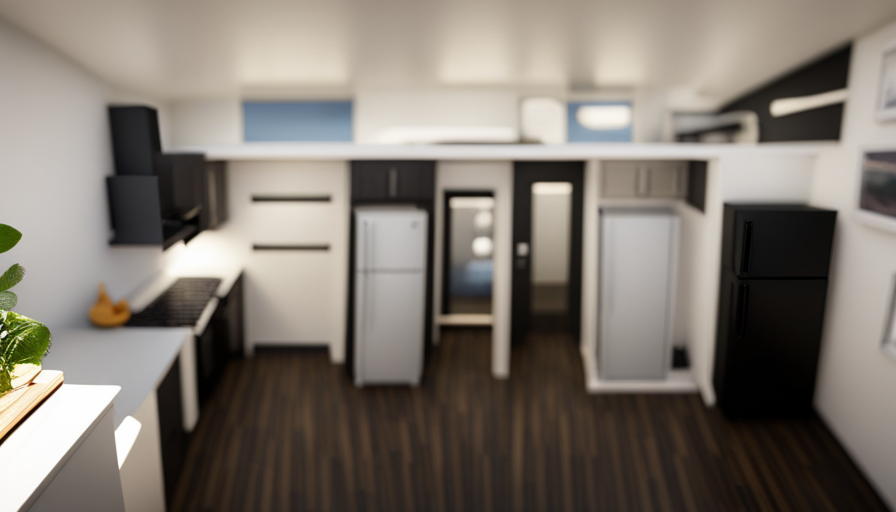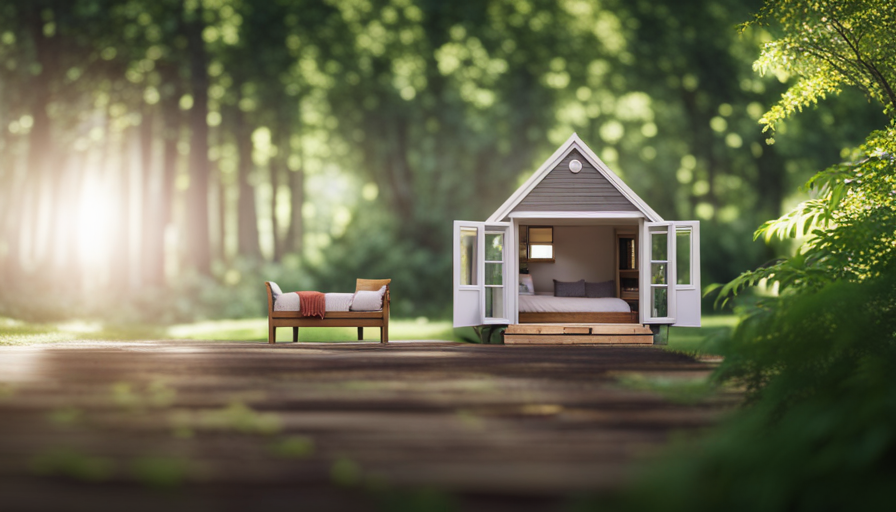Building a small house that covers 1,100 square feet is quite a feat. It is akin to embarking on a journey, where every step is vital in achieving your dream abode. Just like the saying goes, ‘Rome wasn’t built in a day,’ creating your tiny home will take time. However, with careful planning, precise execution, and determination, you can turn this ambitious project into a triumph.
In this article, I will guide you through the various stages of building a 1,100 sq ft tiny house. From the initial planning and research to the final touches and decoration, we will explore the necessary steps to bring your vision to life.
We’ll delve into designing the layout, gathering materials and tools, and constructing the foundation. We’ll then tackle the framing, insulation, and interior finishing, as well as the installation of fixtures and appliances.
Finally, we’ll explore the exterior finishing and add those personal touches that make a house a home.
So, grab your hard hat and join me on this exciting journey of building your very own 1,100 sq ft tiny house. Let’s get started!
Key Takeaways
- Proper planning and time management are crucial in the construction of a 1,100 sq ft tiny house.
- Maximizing space through efficient layout design and the use of multi-purpose furniture and built-in storage is essential.
- Open concept design and efficient use of vertical space can help create an illusion of a bigger living area.
- Hiring professionals for electrical and plumbing installation is important for safety and functionality.
Planning and Research
Before you dive into the construction process, it’s crucial to spend time planning and doing research to ensure that building your 1,100 sq ft tiny house is a smooth and successful endeavor.
Budgeting plays a significant role in this phase, as it allows you to allocate funds efficiently and avoid unnecessary expenses. Create a detailed budget that includes all the necessary materials, tools, and professional services you may need. Conduct extensive research to find the best deals and suppliers, ensuring that you stay within your financial limits.
Time management is another crucial aspect of the planning and research phase. Set a realistic timeline for your project, taking into account your availability, skillset, and potential delays. Break down the construction process into smaller tasks and establish deadlines for each one. This will help you stay organized and focused throughout the project, ensuring that you complete it in a timely manner.
Once you have completed the budgeting and time management aspects, you can move on to designing the layout and floor plan. By carefully considering your needs, preferences, and available space, you can create a functional and aesthetically pleasing tiny house that suits your lifestyle.
Designing the Layout and Floor Plan
To efficiently create your dream tiny house, envision a blueprint that carefully weaves together the threads of functionality and aesthetic appeal, crafting a symphony of space that sings with harmonious efficiency.
Space optimization is crucial in designing the layout and floor plan of a 1,100 sq ft tiny house. Here are some key considerations to maximize the use of every square foot:
-
Multi-purpose furniture: Incorporate convertible and collapsible furniture pieces that can serve multiple functions, such as a sofa that turns into a bed or a dining table that can be folded away when not in use.
-
Built-in storage: Utilize every nook and cranny by incorporating built-in storage solutions like under-stairwell cabinets, wall-mounted shelves, and hidden compartments.
-
Open concept design: Opt for an open floor plan to create the illusion of a larger space. This design concept allows for seamless flow between different areas of the house while maximizing natural light and ventilation.
-
Customizable features: Consider customization options that cater to your specific needs and preferences. This could include adjustable shelving, modular furniture, and flexible room partitions.
-
Efficient use of vertical space: Make use of vertical storage solutions like tall cabinets, mezzanine levels, and hanging organizers to make the most of limited floor space.
By carefully considering these space optimization techniques and customization options, you can create a functional and visually appealing layout for your tiny house. With the blueprint in hand, it’s time to transition into the subsequent section of gathering materials and tools.
Gathering Materials and Tools
With the incorporation of high-quality materials and a selection of essential tools, one can embark on the journey of gathering the necessary resources for their dream tiny house project.
Sourcing materials is a crucial step in the construction process. It involves researching and finding the best options for each component of the house, such as lumber, insulation, roofing materials, and fixtures. It is important to prioritize durability and sustainability when selecting materials to ensure the longevity and energy efficiency of the tiny house.
Additionally, acquiring tools is essential to facilitate the construction process. Basic tools like hammers, saws, drills, and levels are necessary, but specialized tools like miter saws and nail guns may also be needed for more specific tasks. It is important to have a comprehensive list of tools and ensure they’re of good quality to ensure smooth progress during the construction phase.
By diligently sourcing materials and acquiring the necessary tools, one can move forward with confidence to the next phase of the project: site preparation and foundation construction.
Site Preparation and Foundation Construction
Now that you’ve gathered all the necessary materials and tools, it’s time to prepare the site and lay the foundation for your dream home.
The first step in this process is site excavation. This involves clearing the land of any obstacles, such as trees or rocks, and leveling the ground to create a stable surface for the foundation. It’s important to ensure that the site is properly excavated to provide a solid base for your tiny house.
After the site excavation is complete, the next step is soil testing. This is crucial in determining the type and quality of soil present on your property. Soil testing helps identify any potential issues, such as poor drainage or soil instability, that could impact the foundation of your tiny house. Based on the results of the soil testing, you may need to take additional measures, such as adding gravel or compacting the soil, to ensure a strong and stable foundation.
With the site excavation and soil testing completed, you’re now ready to move on to the next stage of building your tiny house. In the subsequent section about framing and insulation, you’ll learn how to construct the structural framework and ensure that your tiny house is well-insulated for optimal comfort.
Framing and Insulation
Once the site excavation and soil testing are complete, the process of framing and insulating your dream home begins, weaving together the bones and warmth of your tiny sanctuary.
Framing techniques play a crucial role in constructing a sturdy and durable structure for your tiny house. Common methods include platform framing, where walls are built on top of the foundation, and balloon framing, where vertical studs extend from the foundation to the roof. Careful attention must be given to ensure accurate measurements and precise cuts for a seamless fit.
Additionally, insulation materials are essential for maintaining a comfortable indoor environment and reducing energy consumption. Common options include fiberglass batts, which are cost-effective and easy to install, and spray foam insulation, which provides superior insulation and air sealing properties. Proper installation of insulation is crucial to prevent air leaks and optimize thermal performance.
As the framing and insulation phase nears completion, the next step involves electrical and plumbing installation, ensuring the functionality and convenience of your tiny house.
Electrical and Plumbing Installation
To ensure the functionality and convenience of your dream home, it’s crucial that you focus on the electrical and plumbing installation.
When it comes to electrical safety precautions, there are a few key factors to consider. Firstly, it’s important to hire a licensed electrician who can handle the installation process professionally. This ensures that all the wiring is done correctly and up to code, reducing the risk of electrical hazards.
Additionally, it’s essential to install ground fault circuit interrupters (GFCIs) in areas where water is present, such as the kitchen and bathroom. These devices protect against electrical shocks and are a vital safety measure.
Moving on to the plumbing system maintenance, it’s crucial to design and install an efficient plumbing system for your tiny house. This involves carefully planning the layout of your pipes, ensuring proper drainage, and using high-quality materials. Regular maintenance is also essential to prevent clogs, leaks, and other plumbing issues.
Inspecting and cleaning drains, checking for any signs of water leaks, and maintaining water pressure are all important steps in keeping your plumbing system in good condition.
Next, we’ll delve into the interior finishing, including walls, flooring, and ceiling, to bring your tiny house closer to completion.
Interior Finishing, including Walls, Flooring, and Ceiling
The final touches of your dream home come alive as the walls embrace you with warmth, the flooring dances beneath your feet, and the ceiling becomes a canopy of dreams.
When it comes to the interior finishing of your 1,100 sq ft tiny house, attention to detail is crucial to create a comfortable and visually appealing space.
Choosing the right paint color is essential to set the desired mood and create a cohesive look throughout the house. Consider the size of each room and the amount of natural light it receives to make an informed decision.
Opting for sustainable flooring options not only benefits the environment but also adds a touch of elegance to your tiny house. Bamboo, cork, and reclaimed wood are excellent choices due to their durability and eco-friendly characteristics.
Once the paint color and flooring are selected, it’s time to focus on the installation. Start by priming the walls and applying two coats of paint for a flawless finish. Lay the flooring meticulously, ensuring each piece is properly aligned and securely fastened. Finally, install the ceiling, whether it be drywall, wood paneling, or a decorative finish.
With the walls, flooring, and ceiling complete, your tiny house is well on its way to becoming a cozy haven. As we transition into the next section about installing fixtures and appliances, remember that every detail counts in creating your perfect tiny home.
Installing Fixtures and Appliances
After completing the interior finishing of the tiny house, it’s time to move on to the next step: installing fixtures and appliances. This phase is crucial as it adds functionality and convenience to the living space.
When choosing fixtures and appliances, it’s essential to consider energy-efficient options to minimize the environmental impact and reduce utility costs. LED lighting fixtures, low-flow toilets, and Energy Star-rated appliances are examples of energy-efficient choices that can be incorporated into the tiny house.
Additionally, space-saving solutions should be implemented to maximize the limited square footage. Compact appliances, such as a combination washer-dryer unit or a slim dishwasher, can save valuable space. Installing built-in storage solutions, such as overhead cabinets and under-counter organizers, can further optimize the available space.
By carefully selecting energy-efficient fixtures and incorporating space-saving solutions, the tiny house can provide all the necessary amenities while still maintaining its compact size.
With the fixtures and appliances in place, the focus can now shift to the exterior finishing, such as siding and roofing, to complete the construction of the tiny house.
Exterior Finishing, such as Siding and Roofing
With the installation of fixtures and appliances complete, it’s time to focus on the exterior finishing of the tiny house, including siding and roofing.
When it comes to siding options, there are several choices to consider. One popular option is vinyl siding, which is low-maintenance and resistant to rot and insects. Another option is fiber cement siding, which offers durability and the look of natural wood. Additionally, there is the choice of wood siding, which provides a rustic and charming aesthetic. Each option has its benefits and drawbacks, so careful consideration should be given to the specific needs and style preferences.
Moving on to roofing materials, there are various options available for the tiny house. One common choice is asphalt shingles, which are affordable and come in a wide range of colors. They’re also relatively easy to install. Another option is metal roofing, which offers durability and longevity. Metal roofs are resistant to fire, rot, and insects, making them a popular choice for tiny houses. Additionally, there is the choice of cedar shakes, which provide a natural and timeless look. These shakes require regular maintenance, but they can add a unique charm to the exterior.
With the exterior finishing complete, the tiny house is now ready for the final touches and decoration.
Final Touches and Decoration
To truly personalize the pint-sized dwelling, consider adding whimsical wallpaper or vibrant paint to the interior walls. This will bring life and character to the space, making it feel like a cozy home.
When choosing furniture for a tiny house, it’s important to prioritize functionality and space-saving designs. Opt for multi-purpose pieces such as a sofa that can transform into a bed or a dining table that can be folded away when not in use.
Finding unique decor items can be a fun and rewarding process. Look for one-of-a-kind pieces at flea markets, antique stores, or even online marketplaces. Incorporating vintage or handmade elements can add charm and personality to the tiny house.
Additionally, consider using clever storage solutions to keep the space organized and clutter-free. Utilize vertical space with floating shelves or hanging racks.
Lastly, don’t forget to add personal touches such as family photos or artwork to make the space feel like your own. With careful consideration and a bit of creativity, the final touches and decoration of your tiny house can truly make it a home.
Frequently Asked Questions
How much does it cost to build a 1,100 sq ft tiny house?
Based on cost estimation and the use of building materials, the construction of a 1,100 sq ft tiny house can vary depending on factors such as location, design, and quality of materials chosen.
However, on average, the cost to build a tiny house of this size can range from $50,000 to $100,000. It’s important to consider the cost of land, permits, labor, and additional expenses when planning the budget for constructing a tiny house.
Is it possible to build a tiny house on a tight budget?
Yes, it’s possible to build a tiny house on a tight budget. When building a tiny house, there are several tips for saving money on construction.
First, consider using salvaged or recycled materials for the build.
Secondly, simplify the design to reduce the overall cost.
Additionally, it’s important to carefully plan and budget for each stage of the construction process.
By following these tips, one can successfully build a tiny house on a tight budget.
What are some common challenges faced during the construction of a tiny house?
When constructing a tiny house, one encounters a myriad of common challenges and construction difficulties. These hurdles can range from limited space for materials and equipment to intricacies in plumbing and electrical installations.
Furthermore, ensuring structural integrity and meeting building codes poses additional complexities. It’s imperative to meticulously plan and strategize every step of the construction process, while also being prepared to adapt and overcome unforeseen obstacles that may arise.
Are there any legal requirements or regulations to consider when building a tiny house?
When building a tiny house, it’s important to consider legal requirements and building codes. These regulations vary depending on the location, but typically cover aspects such as zoning, minimum size requirements, and safety standards. It’s crucial to research and comply with all applicable laws to ensure a legal and safe construction process. Building authorities can provide specific information regarding the legal requirements for building a tiny house in a particular area.
Can a tiny house be easily relocated or moved to a different site after it’s built?
Relocating a tiny house is akin to moving a delicate piece of artwork. It can be done, but it requires careful planning and consideration. The pros of moving a tiny house include the ability to explore new locations and adapt to changing circumstances. However, there are cons to consider as well. Moving a tiny house can be costly, time-consuming, and may require permits and transportation logistics. Overall, relocating a tiny house is possible, but it’s important to weigh the pros and cons before making the decision.
Conclusion
In conclusion, building a 1,100 sq ft tiny house is an intricate process that requires careful planning, precise execution, and dedication. Just like constructing a masterpiece, each step contributes to the overall beauty and functionality of the final product.
From the initial research and design phase to the final touches and decoration, every detail matters. It may take several months, but the result is a cozy and efficient living space, like a perfectly crafted painting that brings joy and fulfillment to its creator.
Hi, I’m Emma. I’m the Editor in Chief of Tiny House 43, a blog all about tiny houses. While tree houses are often associated with childhood, they can be the perfect adult retreat. They offer a cozy space to relax and unwind, surrounded by nature. And since they’re typically built on stilts or raised platforms, they offer stunning views that traditional homes simply can’t match. If you’re looking for a unique and romantic getaway, a tree house tiny house might just be the perfect option.










